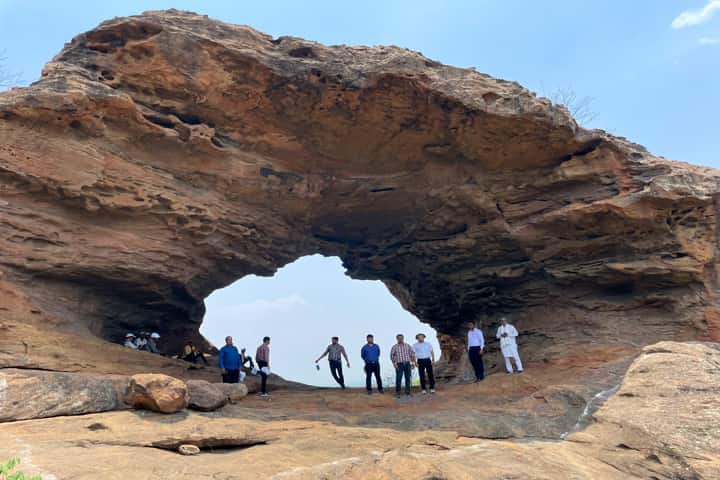

The GSI team during its survey have discovered a natural arch that is bigger than other two in Tirupati and Andaman and Nicobar (Pic. Courtesy Twitter/@Lalit_ifs)
During the exploration of coal in Kenduadihi block in Odisha’s Sundargarh district, a team of the Geological Survey of India have discovered an important geographical formation. It is a natural arch that has been identified by the team during their survey of the area.
As per the GSI scientists the formation dates back to about 184 to 160 million years in the lower to middle Jurassic age.
The GSI team, considering the scientific and academic significance and its aesthetic value has stressed that “efforts may be undertaken to preserve this place as a national geo-heritage site.”
Located within the dense Chhengapahar Reserve Forest near Brahmani village, the natural arch is surrounded by cliffs and steep sloped hills. In his report Saptarshi Mallick, a geologist with GSI sharing details of the formation has said: “The natural arch has a maximum length of 30 metres at the base and maximum height of 12 metres. The alcove of the natural arch, has maximum height and width of 7m and 15m respectively and geometrically the arch is oval shaped.”
Interestingly the arch has an ancient cultural and mythological connection. Talking about this aspect with India Narrative, Lalit Kumar Patra, Divisional Forest Officer Bonai who is also in charge of Sundargarh Forest Division where the natural arch is located said: “The hill is named after this natural arch which has a hole. Chhenga in local language means ‘hole’, so the name Chhengapahar or Chhenga Hill. Apart from this, according to legend, it is said that when Lord Rama was hunting for the ‘mrigaya’ or the golden deer, the arrow he shot at the animal made a hole in the rock and landed on the other side of the hill.”
The “Report on the Natural Arch….” by Mallick, a copy of which has been accessed by IN states that the physical characteristics of the rocks shows that the hill is “coarse to gritty sized, flesh red coloured, poorly sorted, immature, ferruginous sandstone of Kamthi Formation of Upper Gondwana Group.”
Touching upon the formation of the geographical structure, the report said it is “structurally triggered-weather eroded natural arch”. As per the report it came into being “by the fault system and associated joints” while the sandstone accelerated the process through subaerial weathering which included rain water percolation and temperature fluctuation.
Besides this arch there are two more in India. While one is located at Tirumala hills in Tirupati the other one is in Andaman and Nicobar. Both are smaller when compared to the one in Sundargarh. Summing up the find the GSI report said: “Presence of the natural arch may certainly be seen as a new feather in the crown of natural history of Odisha.”
The arch is bound to become an attraction for both the national and international tourists. Highlighting this for India Narrative Patra observed: “The tag will encourage geo-tourism activities thereby adding to the livelihood of the local communities who will take initiative and steps to protect the site. Being located inside RF, restricted and responsible tourism will be allowed. Also, awareness among the local people including the members of Van Suraksha Samiti will be created to conserve the place.”
He went on to add: “As the arch is located in Chhengapahad Reserved Forest it will be safeguarded under Indian Forest Act 1927. The geo heritage tag will enhance its importance for both local administration and scientific communities, thereby making its preservation vital.”
Prime Minister Narendra Modi-chaired CCEA, in a meeting on Wednesday, granted enhanced autonomy to Maharatna…
Baloch activists Dr. Naseem Baloch, Chairman of the Baloch National Movement (BNM), while speaking at…
Union Commerce and Industry Minister Piyush Goyal met with deeptech startups and discussed ways to…
Taiwan's Ministry of National Defence (MND) stated that it had detected 18 Chinese military aircraft,…
External Affairs Minister S Jaishankar on Tuesday called on member nations of the Shanghai Cooperation…
External Affairs Minister S Jaishankar held a meeting with his Russian counterpart, Sergey Lavrov, on…